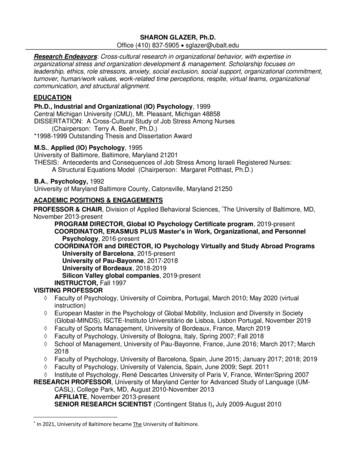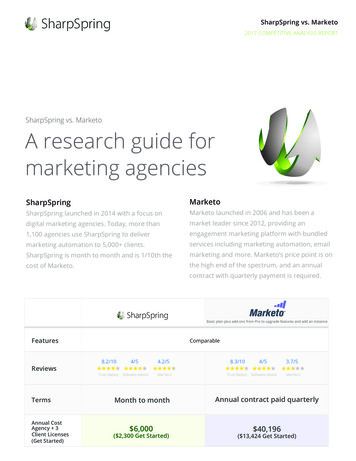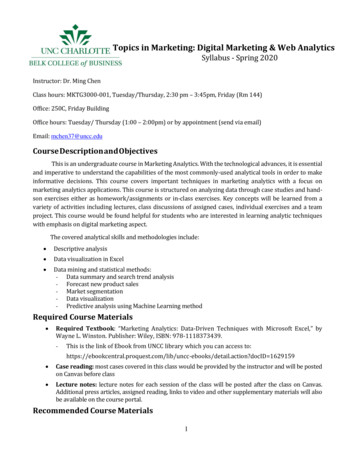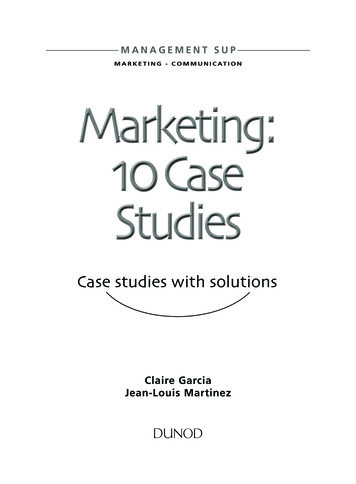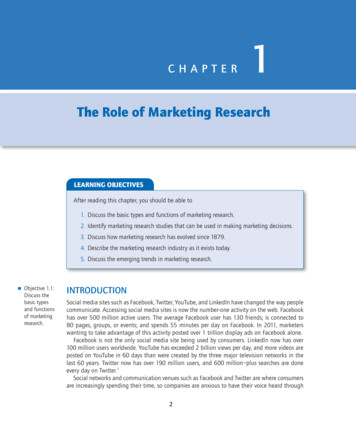
Transcription
CHAPTER1The Role of Marketing ResearchLEARNING OBJECTIVESAfter reading this chapter, you should be able to1. Discuss the basic types and functions of marketing research.2. Identify marketing research studies that can be used in making marketing decisions.3. Discuss how marketing research has evolved since 1879.4. Describe the marketing research industry as it exists today.5. Discuss the emerging trends in marketing research. Objective1.1:Discuss thebasic typesand functionsof marketingresearch.INTRODUCTIONSocial media sites such as Facebook, Twitter, YouTube, and LinkedIn have changed the way peoplecommunicate. Accessing social media sites is now the number-one activity on the web. Facebookhas over 500 million active users. The average Facebook user has 130 friends; is connected to80 pages, groups, or events; and spends 55 minutes per day on Facebook. In 2011, marketerswanting to take advantage of this activity posted over 1 trillion display ads on Facebook alone.Facebook is not the only social media site being used by consumers. LinkedIn now has over100 million users worldwide. YouTube has exceeded 2 billion views per day, and more videos areposted on YouTube in 60 days than were created by the three major television networks in thelast 60 years. Twitter now has over 190 million users, and 600 million–plus searches are doneevery day on Twitter.1Social networks and communication venues such as Facebook and Twitter are where consumersare increasingly spending their time, so companies are anxious to have their voice heard through2
Chapter 1: The Role of M ar keting Research3these venues. But, getting consumers to become a fan or agree to receive e-mails is only half of thebattle. Engaging them with the brand and encouraging them to become active followers throughthese social media tactics is equally, if not more, difficult. While consumers join a company’sFacebook page, or agree to receive e-mails and tweets, many are also opting out after a short time.For companies using social media, understanding why individuals opt out after agreeing to be a fanis important information. To gather this information, ExactTarget CoTweet surveyed 1,561 onlineusers in the United States.2 Figure 1.1 shows the results of the survey.The top reason consumers quit being a brand fan on Facebook is because the company authorstoo many posts, which in turn clutters the recipients’ wall with marketing information. The factthat messages tend to be repetitive, boring, and irrelevant, and are perceived by many fans asbeing overly promotional, is also an important factor in influencing fans to quit a brand’s Facebookpage. Companies can use these results to modify their marketing approach and how they authorFacebook posts.This type of information is provided by marketing research, which is defined as the systematicgathering and analysis of marketing-related data to produce information that can be used indecision making. Marketing research involves following a systematic sequence of steps that willproduce reliable and valid data. Through analysis and interpretation the data are transformed intoinformation suitable for decision-making purposes by managers. Typically, data alone are simplynot usable. It is the analysis and interpretation of the data that makes them useful to managers.Figure 1.1 Top Reasons Consumer Quit Brands on Facebook50%Percent of 5%0%Too manypostsWall clutteredwith marketingMessagesrepetitiveand boringPosts overlypromotionalContentirrelevantSource: Author-created with data from “The Social Break-up,” Report #8, ExactTarget CoTweet, 2011, http://www.exacttarget.com/Resources/SFF8.pdf (retrieved June 9, 2012).
4 S EC T I O N 1 : I N T RO D U C T I ON TO M A RKETI NG RESEA RCHFigure 1.2 provides an example of marketing researchers turning data into useful information.3In this situation, consumers were asked the question, “In a typical week, how many hours do youspend with each of the following media?” The marketing researcher took the raw data, which wasthe number of hours spent with each type of media, and converted it into the percentage of timespent with each type of media. This allowed marketers to see that consumers now spend almostas much time with the Internet as they do with television. Further, almost 70% of consumer mediatime is spent either with television or with the Internet.Figure 1.2 Percent of Time Consumers Spend With Each MediaMagazines, 6%Radio, 18%Newspapers, 7%Internet, 34%Television, 35%Source: Author-created with data from Shar VanBoskirk, “US Interactive Marketing Forecast, 2009 to 2014,” Forrester Research Inc.,July 6, 2009 (updated July 20, 2009). MARKETING RESEARCHMarketing research may be conducted internally by the firm’s marketing department orperformed externally by a marketing research firm. The information gathered is then used tomake decisions related to the marketing mix or other marketing functions. The marketing mixis the specific combination of product, pricing, promotional, and distribution decisions madefor the purpose of targeting a particular group of consumers. Some of the more commonmarketing uses of research information include market segmentation, identifying specifictarget markets and their media habits, analyzing consumer behavior and needs, trackingcustomer satisfaction, developing new products, and evaluating various forms of advertisingexecutions and pricing tactics. But, the use of marketing research information is not limited tojust the marketing department. It can be used by all levels of management to make decisions
Chapter 1: The Role of M ar keting Research5that impact other aspects of a firm’s operation. It can guide top management in makingstrategic decisions about acquisitions, divestitures, and expansion. It can be used by middlemanagers to develop production schedules, purchase raw materials, develop departmentalbudgets, and determine appropriate staffing levels.Functions of Marketing ResearchAs shown in Figure 1.3, marketing research serves four primary functions within an organization. The exploratory function of marketing research occurs when researchers have a limitedunderstanding or no knowledge at all about a marketing situation or a particular outcome. Forexample, a company may be losing customers or sales maybe declining, but managers are not sure why. MarketingFigure 1.3 Functions ofresearch can be used to explore some of the possible causesMarketing Researchof lost sales or customers. Alternatively, a firm may be considering offering a new product in a category with which Exploratoryit has little experience. In this case, marketing research Descriptivecould be used to delve deep into a consumer’s mind to Diagnosticuncover some of the hidden reasons or thought processes Predictivethat go into making a purchase decision for the type ofgood being considered.Marketing research often serves a descriptive function, which refers to the gathering and presentation of information about a marketing phenomenon or situation. Forexample, marketing research can be used to describe the primary consumer of a product,such as a Panasonic HDTV or a John Deere tractor. It can be used to describe the process acustomer uses in deciding on a restaurant for dinner, such as Romano’s Macaroni Grill orOutback Steakhouse. Figure 1.4 illustrates the descriptive function of marketing researchsince it shows the primary reason individuals watch the Super Bowl football game. Whilethe majority, 55%, are mostly interested in the football game, some watch it specifically tosee the commercials (15%), and others watch for the social aspect of being with family andfriends (27%).4The diagnostic function of marketing research is particularly helpful in many situations.Here, data analysis techniques are used to investigate relationships and phenomena within datathat have been gathered through marketing research. The analysis may show that females eatat Olive Garden more frequently than males. It may show the reasons individuals opt out ofsubscribing to a Facebook brand page, as was shown in Figure 1.1. Further analysis of the datamay show different reasons for opting out of a Twitter feed and an e-mail permission program.The diagnostic function is important to marketers because it allows marketers to discoverinterrelationships with data.The predictive function of marketing research allows data to be used to predict or forecastthe results of a marketing decision or consumer action. Retailers use predictive research todetermine what items a consumer is likely to purchase together so suggestive selling can be used.Barnes & Noble utilizes this technique when website customers select a particular book and thesoftware then suggests other books they might also want to purchase. Marketing research canbe used to estimate the impact of a coupon or another sales promotional offer. It is often usedto estimate the market share of a brand extension or new product introduction.
6 S EC T I O N 1 : I N T RO D U C T I ON TO M A RKETI NG RESEA RCHFigure 1.4 Primary Reason Individuals Watch the Super BowlOther reasons, 3%To be withfamily/friends, 27%To see footballgame, 55%To see theadvertisements, 15%Source: Author-created with data from “Super Bowl Sunday Consumer Survey,” Super Bowl XLV (January 2011), LightspeedResearch, p. 17.Applied Versus Basic ResearchMarketing research can be either applied or basic. Applied marketing research is designed tosolve a specific marketing problem, to investigate a particular marketing phenomenon, or to understand the results ofprevious decisions. The previous research investigating whyconsumers opt out of a brand’s Facebook page and whyindividuals watch the Super Bowl are examples of appliedresearch. Most commercial marketing research and researchconducted internally by research departments is appliedresearch since companies are seeking solutions to problemsor information that can help them exploit potential opportunities. Marketing research should provide informationthat will allow managers to make better marketing decisions.Basic marketing research is more theoretical innature and is conducted to advance marketing knowledgein general or to verify a proposed marketing theory orconcept. Findings from basic research studies cannot beimplemented by managers in the short run. This is becausebasic research is typically not conducted in the context ofa particular brand or firm, or for the purpose of solving aUnderstanding why individuals watchspecific marketing problem or exploiting an opportunitythe Super Bowl football game is anfacinga given brand or firm.example of applied research.
Chapter 1: The Role of M ar keting Research7Most basic marketing research is conducted by academicians in an effort to advance ourknowledge of marketing. For instance, many research studies use questions to assess how consumers claim they will act when confronted with a given situation. A recent basic research studyevaluated four different methods by which consumers’ willingness to pay for an item is commonlymeasured in consumer research studies, and compared the results with actual purchase data inan effort to ferret out the relative strengths and weaknesses of each measurement technique.5The results of this study cannot be immediately applied to any particular problem facing a firm,but rather serve to advance our knowledge of marketing research practices. However, in thefuture, the results of the study may influence the types of questions asked as part of an appliedresearch study commissioned by a firm that needs to investigate consumers’ willingness to payfor their product as part of a larger research study.The Philosophy of ScienceThe philosophy of science underlies researchers’ efforts to make sense of the world and its variousactivities and events in a wide variety of disciplines. The philosophy of science assumes that fora given event or activity, causes or “antecedents” can be identified, meaning that things don’t justhappen; they happen for a reason. Thus, scientific research seeks rational and logical explanationsfor activities or events that are true the vast majority of the time. Most marketing researchersdesire to be 95% confident that the results of their research efforts are accurate and unlikely tohave occurred by chance. The philosophy of science also tends to value a more general understanding of events or phenomena (i.e., why Facebook fans quit “liking” brands), as opposed tounderstanding of a particular event (i.e., why Facebook fans of Diet Coke quit “liking” the brand).This is because such knowledge is useful in forming theories and because it allows a scientific lawto be generalized, meaning it can be applied to a larger group of activities or events. By contrast,the reasons why Diet Coke Facebook fans “quit” liking the brand may be unique to Coca-Cola,and though this information would be helpful to the firm from a broad scientific standpoint, theinformation would be not at all useful in the formulation of theory or scientific law.Another characteristic inherent in the philosophy of science is that science, by its verynature, is empirically verifiable, meaning that the theories and laws created can be testedthrough the collection and analysis of data. The nature of science and empirical testing issuch that we can never totally prove a theory to be true; however, the more a theory is subjected to testing under different conditions, and the more empirical testing fails to disprovethe theory, the more confident researchers can be in the validity, or truthfulness, of theresults. So part of the research process is to also investigate the specific conditions underwhich a law or theory could be disproved.Finally, the philosophy of science requires that researchers remain open to the possibilityof change and modification. It is common for a scientific theory to be tested over time andeventually disproven in too many circumstances, ultimately leading to better theories withgreater explanatory value.6The Scientific MethodIn conducting marketing research, it is important that researchers follow the scientific methodshown in Figure 1.5. The research process begins with a thorough investigation of current
8 S EC T I O N 1 : I N T RO D U C T I ON TO M A RKETI NG RESEA RCHknowledge. Whether applied or basic research, marketing researchers should examine current knowledge on the topic and review prior research. This typically involves examiningpast research studies, academic articles, news articles, and facts, figures, and statistics from avariety of sources. From this state of current knowledge, researchers can develop a theory thatexplains the nature of what is being studied, followed by one or more hypotheses. The nextstep is to design a study and then collect the data to test the hypothesis. It is important to statethe hypothesis prior to collecting data to prevent the data from biasing the hypothesis in anyway. From the data, the researcher can draw conclusions, advance theories, and create newknowledge that can be used for future research. The cycle then begins again.Figure 1.5 The Scientific heoryAdvancementCurrentKnowledgeNewKnowledge Objective1.2: Identifymarketingresearch studiesthat can beused in makingmarketingdecisions.MARKETING RESEARCH AND DECISION MAKINGThe primary objective of conducting marketing research is to support marketing decisions.Managers will never have perfect knowledge, and as a result there will always be some uncertaintyin choosing a course of action. But, through marketing research, the amount of uncertainty canbe reduced, allowing the manager to be more confident the correct or best decision is beingmade. Marketing research plays a role ina number of marketing areas, as shown inFigure 1.6 Marketing Research and MarketingFigure 1.6.DecisionsSegmentation andTargetingMarketing research provides essentialinformation for decisions on segmentationand targeting. Benefit and lifestyle studiesexamine the similarities and differencesconsumers seek in products and how these Segmentation and targeting Product development Marketing communications and mediaselection Market and competitive analysis Pricing and sales potential/forecast studies Site selection and distribution studies
Chapter 1: The Role of M ar keting Research9benefits fit into particular lifestyles. This information is then coupled with target market analysis, which provides basic demographic, geographic, psychographic, and behavioral informationabout specific target markets. From these research studies, marketers can decide which segmentsbest match the features of their brands. Details such as usage patterns, attitudes, preferences, andlifestyles will allow a company to make better segmentation and targeting decisions.Product DevelopmentMarketing research is used in all stages of product development. Research can be used in theconcept stage to gather customer input on ideas for a new product or modifications of a current product. Product testing studies identify how a product fits the needs of consumers andwhat changes need to be made to the product to make it more attractive. Test markets can beconducted to provide information on how well a new product or product modification will dobefore the product is launched. Modifications and decisions that will increase the probabilitythat the new product will be successful can be made based on the results of the test market.Marketing Communications and Media SelectionMarketing research can provide valuable information concerning marketing communications(MarCom) and media selection. Advertising effectiveness research examines the effectivenessof advertising and marketing communications. These studies can be conducted on a continuous basis and compared to a benchmark, previous ad campaigns, or competitive advertising.Input from these research studies allows marketers to develop more effective advertising andmarketing communications. It also can identify when consumers are not paying attentionany longer and allows for detection of when an ad is wearing out. Media studies are used toidentify the most appropriate media to reach a specific target market. In addition to the bestmedia, media studies will also identify the best vehicles, such as the best magazines or the besttelevision shows to use.Market and Competitive AnalysesA market analysis study will examine the current marketing situation faced by a companyor brand and then identify potential markets. While market analysis studies are especiallyimportant for new products or entry into new markets, the studies are also important for current products, as market dynamics change. Companies can lose market share quickly if theydo not stay in touch with current consumer behavior trends. Just like market analysis studies,competitive analysis studies should be conducted regularly to ensure market share is not lostto competitors. Many organizations will use a marketing information system to gather marketand competitive information on a continuous basis.Pricing and ForecastingPricing is an important determinant in buying decisions, so pricing studies can be used toevaluate the elasticity of a brand’s price and the impact pricing changes will have on demand.
10 S EC T I O N 1 : I N TRO D U CTI ON TO M A RKETI NG RESEA RCHPart of a pricing study is to examine competitors’ prices and determine how consumers (orbusinesses) evaluate price relative to other product features. Additional studies, such as salesforecasts and sales potential studies, are used to estimate future sales. These studies are oftenused for budgeting, production, and staffing decisions.Site Selection and DistributionFinally, site selection studies help retailers determine the best locations for their stores. Otherresearch studies can help determine whether a single- or multichannel distributi
The top reason consumers quit being a brand fan on Facebook is because the company authors too many posts, which in turn clutters the recipients’ wall with marketing information. The fact that messages tend to be repetitive,



